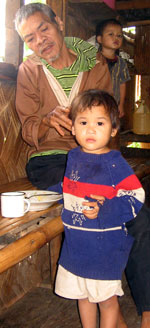
Most Affected. Poor families in the rural areas, such as this father and his two children, are most affected by the lack of resources for health. (davaotoday.com photo)
Mothers feeding their infants with condensed milk. A flea from a buffalo is considered a cure for toothache. The sick crossing rivers and climbing mountains to get to a nearest hospital. Most pregnant women not being able to see a midwife, let alone a doctor. These are the stories from poor communities that a health group gathered in its attempt to diagnose the state of people’s health in Mindanao.
By Cheryll D. Fiel
davaotoday.com
DAVAO CITY � The conventional wisdom is that, poverty being so widespread in the Philippines, the state of health of poor Filipinos leaves much to be desired. In Mindanao, where most of the country�s poorest provinces are located, the problem is particularly more acute.
A recent survey conducted by the nongovernment health group Community Based Health Services Association (CBHSA) affirmed many of the sad realities of the Philippine health care system, particularly in Mindanao. Many of the afflictions Mindanaoans suffer were preventable, the study found out, but these diseases became chronic and incurable because of the widespread poverty and lack of health services.
According to the group�s �Community Diagnosis� or �Mindanao CDx,� the lack of resources for health has resulted in dire situations for Filipinos in these poor communities.
To be sure, there had been similar studies conducted in the past, according to Dr. Ma. Lourdes Alisasis, a volunteer physician of the CBHSAMindanao Project Management Desk, but none were as organized and as extensive as the CBHSA�s �Community Diagnosis.�
The Mindanao CDx surveyed 3, 579 respondents in 38 barangays in these Mindanao provinces: Agusan del Norte, Agusan del Sur, Bukidnon, Camiguin, Compostela Valley, Davao del Norte, Davao del Sur, Lanao del Norte, Landao del Sur, Misamis Occidental, Misamis Oriental, Saranggani Province, South Cotabato, Surigao del Norte, Surigao del Sur and Zamboanga del Norte.
The survey was supported by the AID-Uprooted Program (Philippines) of the European Union- Delegation of the European Commission to the Philippines.

Findings. Dr. Ivy Boyose-Nolasco of the Urban Integrated Health Services Foundation Inc. gives her reaction to the findings of the Mindanao Community Diagnosis presnted by CBHS. (davaotoday.com photo by)
What makes this survey unique, according to CBHS project director Dani Beltran, is that it used the principle of “concrete analysis on concrete condition” � a method that goes beyond determining the symptoms and the superficial causes of diseases and illness and looks instead at the many other factors that, at first glance, may have nothing to do with medicine.
For instance, it used to be that Mindanaoans considered tuberculosis as the top illness. Today, however, they are more worried about hypertension. The CDx teams found out that hypertension was the number one illness among respondents, which is curious in itself if only for the fact that hypertension is usually thought of as a condition that afflicts the rich and the middle class.
But the CDx established that many of the food that the poor respondents could afford are top causes of hypertension, among them salted fish and fish paste (ginamos), probably the cheapest alternative to viand that is also very salty.
“If we want to have a comprehensive health care delivery system at the community level, we must be able to systematically learn and analyze as well the different structures and relations in the community: the economic, political, socio-cultural and historical background of the people and their community,” Beltran said.
“Just like the rich, the poor, too, can get hypertensive due to the food they set on the table,� Beltran said. �But it is important to note that they get hypertensive, because they do not have much choice.”
Food, Poverty







